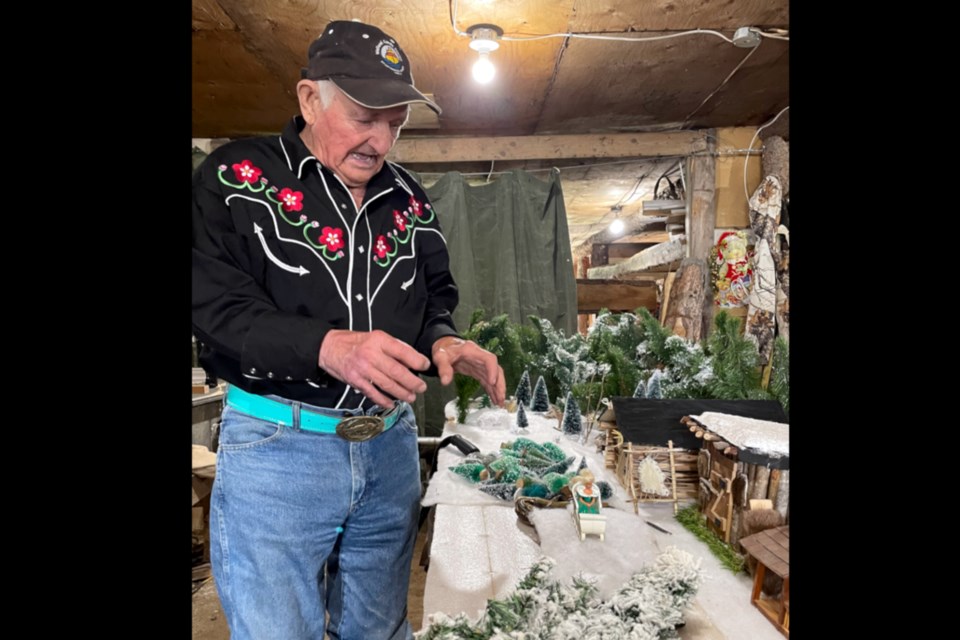ATHABASCA, Alta — It’s been the journey of a lifetime, both through memories and an extensive diorama which has taken years to create.
Louis Baron, 91, has been working on his passion project for the last 12 years — carving here, sewing there, reshaping this, covering that — and now he has a 40-foot sea can packed with a diorama starting with when the land was covered in trees, to a homestead, to a town, and many of the items are straight out of his own memories.
Baron was born in Montreal and came west with his parents and when the time came for him to have his own home, he and wife Alice chose a parcel of land north of the Athabasca River covered in bush.
“(I used) the horses for everything, pulling the stumps out, it was easy,” he said. “And then a breaking plow to open the land.”
A trip to town in the sleigh meant leaving at 7:30 a.m. to get to Athabasca by 11 a.m., do some shopping and head back before supper.
“I said the cheapest and best butter you could get was (from) kids,” he said. “They hold a jar (of cream) in the wagon and the road was rough, we'd get to town and it was almost done. We’d leave it in the wagon and by the time we come home it was butter.”
And up until just a handful of years ago, Baron still had his team of horses active and working on the farm. Before that he would take them in horse pulls in places like Barrhead and Westlock.
“I trained the horses for the neighbour because their dad had a sawmill, and he couldn’t even get the horse to pull the log,” he said. “One day for me, go over there, a little trick I learned while I was growing up with horses.”
Voila, the horse pulled the logs, something depicted in his diorama and in photographs in his leather shop where he makes all the tiny harnesses for his models.
“I've got two sewing machines, but they are over 100 years old,” he said. “You gotta crank one, do the one back and forth but the tools like to put the spots in everything I made them myself because every one of them to get separate (costs a lot).”
The antique leather sewing machine is carrying on a family tradition too. It’s hand operated and there’s no safety guard – safety wasn’t as much of a concern 100 years ago – but he used it to make all sorts of harness equipment for himself and others and still uses it to make all sorts of things like leather picture frames, keychains, besides making his miniatures look realistic.
“My mum’s father was a harness maker back in the 1900s and I remember in 1947/1948 (I got a) saddle horse where I was working and started to make my own bridle and breast collars,” he said.
Baron has shown parts of his diorama over the years and it’s as important to the people looking at it as it is to him to ensure the details are correct.
“A lady out at Colinton, she said the blacksmith had an apron on too, but I said look down there, I made a little apron and a little hammer to drive the nails.” he said. “I even made a cap for him.”
From people in the shops to meat in the butcher’s window – made from plasticene and painted to look like steaks and roasts, every detail matters.
He doesn’t take all the pieces if he is asked to set them up somewhere though, some are just too big to travel with, but he is more than happy to give a guided tour and talk about his life.
“(When) I was growing up and learning and when I left home of course, I started working for farmers for so many months,” said Baron. “Then I leave this place and go into the logging camp and learning; all of that grew on you. And then I ended up in a blacksmith shop and that was something new again.”
All of these memories have been stored in his brain, which is as sharp as ever, and has been the basis of his diorama.
“Some of the buildings or carving horses out of wood pieces and shaping them up and making the little collar and harnessing them up and you could spend a month just on one building, because it's got to be exactly the way it was back in the 1920s and 30s,” said Baron.
And to make his landscape-through-the-ages he uses cast off and recycled materials, the odds and ends no one wants, and it can lead to some hilarious interactions.
“I was in the Riddle store and had a bag of ladies shoes and a woman asked me why I needed so many shoes,” he laughed. “I told her I wore them when I was plowing with the horses. The heels were good for digging in and I had broken a few heels so needed more.”
And it’s the creativity which is as fascinating as the complete diorama where he’s fashioned a wash basin from half of a tomato juice can or used pipe cleaners cut to size, dipped in glue then in rice and painted yellow to make bundles of grain.
“That little harrow, I had to figure out the length of it from the recycling, drill all the holes, put the pins in it and then make the little single tree to fit the horse and the harness and put up the garden,” he said.



